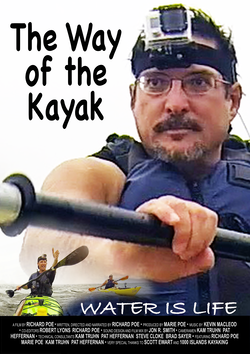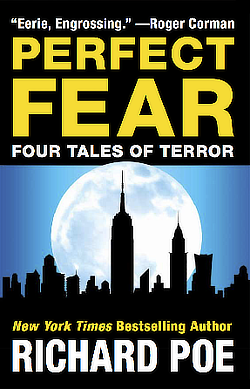PERFECT FEAR: AUTHOR INTERVIEW, PART 1
A Conversation with Richard Poe, Author of Perfect Fear
by Paul Germano
| NEXT PAGE » |
Perfect Fear marks a new direction for bestselling author Richard Poe. At age 53, he has suddenly decided to publish his first work of fiction, a collection of horror tales. Why horror? Why now? In this interview, Poe addresses these questions and others.
Poe and I go back a long way. Both natives of Syracuse, New York, we met in 1984, when Poe joined the staff at the Syracuse New Times. For out-of-towners, the New Times is our local city weekly, a paper whose “alternative” or countercultural edge makes it a kind of Central New York version of the Village Voice. Poe and I became fast friends at the New Times, largely because of our shared politics. We saw ourselves as the true progressives on the staff, disdaining what we regarded as the paper’s safe brand of milque-toast liberalism.
|
POE: Perfect fear is the ultimate fear. It’s fear without limit. Fear without boundaries. It can strike you anywhere, any time, even in broad daylight, in a room full of people. |
|

Some people may be surprised to hear that Poe was a progressive in those days. Many know him today as a conservative commentator, who shows up frequently on venues like the Glenn Beck show. But I can personally attest that he was a leftwing radical when I met him. And I believe he still has a lot of that old radical spirit in him.
At the New Times, Poe exuded the confidence and cockiness of someone who was going places. In those days, he had a kind of Jackson Browne look about him, cool and understated. He was lean, with longish dark hair and very dark, intense eyes. When Poe spoke to you, he focused on you, in a serious way, paying close attention to what you said. He struck me as one of those people who thinks before talking. Poe always spoke in calm, measured tones, in a way that demanded attention.
HOMETOWN BOY MAKES GOOD
In 1985, Poe packed his bags and headed for New York City. He told me he’d rather be a small fish in a big pond, than a big fish in a small pond. And he took to those New York waters right from the start. Within days after leaving Syracuse, Poe landed a job at the East Village Eye, a hotshot Manhattan publication that covered the downtown art scene. Before a month had passed, Poe was managing editor of the Eye.
He just seemed to leapfrog from one success to the next. He was a reporter at The New York Post, then a senior editor at SUCCESS magazine, then a New York Times bestselling author. Poe was the hometown boy who made good.
|
GERMANO: Perfect Fear is a great little book. I enjoyed these stories. They were intelligent and creepy — very, very, very creepy. |
|

While Poe staked his claim in the Big Apple, I remained rooted in Syracuse, working for various Central New York publications over the years, and writing about music, art and pop culture. Somewhere along the ride, I started writing fiction. My first short story was published in 1997 in a small, literary magazine, and I published my first horror story in 2001.
It was on a Sunday morning, the day before Halloween, 2011, that Poe called me from New York and asked me to do this interview. I was honored, of course. But why me? Poe had his reasons: He said he needed someone with a journalistic background; Poe also liked the idea of being interviewed by someone who’d known him for a long time, a fellow Catholic, a fellow Syracusan, and a fellow horror writer. (Horror is not my main focus, but I have published some tales in that genre, including my nasty little story “Lunch Hour” which appeared in the horror anthology Soup of Souls, in 2011; plus I also have my own horror collection, Chill, in the works.) And so we proceeded. The interview that follows was edited from two phone interviews conducted in November and December 2011, plus numerous side conversations on the phone and a healthy dose of e-mail exchanges.
|
GERMANO: “Scotophobia” was like one of those movies that always has another scare around the corner. … I’m a little claustrophobic, so the cramped spaces got to me… crawling down holes, and going through narrow little tunnels… going deeper and deeper down, into the darkness, with no way out, like descending into hell. |
|

Poe still resides in New York City, and I’m still happily ensconced in Syracuse. Poe lives with his wife Marie, a freelance television producer, and I live with my dog April, a strong, muscular and lovable pit bull. So please make yourself comfortable and listen up, as two old friends from Syracuse talk about fear, horror writing, and things that go bump in the night.
________________________________________________
Germano: Perfect Fear is a great little book. I enjoyed these stories. They were intelligent and creepy — very, very, very creepy.
Poe: Thank you!
Germano: What would you like to tell readers about Perfect Fear?
Poe: It’s a collection of horror stories, four tales of terror. The first one is called, “Scotophobia,” which means fear of darkness. It tells the story of Frank Romain, an urban archaeologist who moves to New York City because he’s afraid of the dark. Frank figures he’ll always be safe in New York, because it’s the city that never sleeps, and the lights never go out. But, one day, Frank walks down a mysterious staircase in his East Village tenement and stumbles into an alternate Manhattan, which is dark and terrifying beyond his wildest nightmares. And so Frank learns that he can run, but he can’t hide. Even in the city that never sleeps, sometimes the lights go out.
Germano: Without revealing too much of the plot, can you say a little more about what happens to Frank when he goes down that staircase?
Poe: He finds himself in an underground world beneath the streets of Manhattan, where all the horrors of the past come to life. All the fears, folklore and urban legends of every New Yorker who ever lived become real, including some rather bone-chilling legends from American Indian folklore.
|
POE: Whatever anxiety or discomfort you may have suffered from my stories, I am, of course, delighted to have been the cause of it. |
|
Germano: And what about the other three stories in the book?
Poe: The second story is called, “The Strange, White Room.” It’s about a scientific experiment which goes horribly wrong. A team of scientists sets out to crack the secret of immortality, by making digital copies of human minds. The experiment succeeds, but the scientists discover that eternal life is not all it’s cut out to be. The third story is, “Don’t Come Back, Mommy.” It tells of a little boy whose family spends summers on the beach. The boy listens all night to the crashing surf and imagines that someday, something dreadful will come out of the sea. And, one day, something does. Unfortunately, for that little boy, the thing that comes out of the sea turns out to be his own mother, dead and drowned, and in a very bad mood. The fourth and final story is called, “The She-Wasp.” In that tale, a riverboat expedition makes its way up the Amazon into unexplored territory. The explorers find themselves in a stretch of jungle where little has changed since the Carboniferous period, the age of giant insects, more than 300 million years ago.

Germano: I think “The She-Wasp” was my favorite. In some ways, it reminded me of The Creature from the Black Lagoon, maybe because they’re on a riverboat going up the Amazon. But the creature in those Black Lagoon movies was somewhat cuddly compared to the giant she-wasps in your story.
Poe: I love The Creature from the Black Lagoon. I’m sure it did have some influence, along with a more recent film, Anaconda. But a more direct inspiration for that story would probably be The Lost World, by Sir Arthur Conan Doyle. Just substitute giant insects for dinosaurs.
Germano: “Scotophobia” was also very movie-like. It was like one of those movies that always has another scare around the corner. It had all these different things that people are afraid of, almost as if you were saying to your readers, I’m going to find something to scare you. If you’re not scared of bugs, there’s alligators, and, if you’re not scared of alligators, there’s something else.
Poe: Yes, it’s a smorgasbord of terrors.
Germano: I’m a little claustrophobic, so the cramped spaces got to me. Frank and his wife were always crawling down holes, and going through narrow little tunnels, and they just kept going deeper and deeper down, into the darkness, with no way out, like descending into hell. It was just so creepy!
Poe: Whatever anxiety or discomfort you may have suffered from reading my stories, I am, of course, delighted to have been the cause of it.

Reprinted from Perfect Fear (released by Heraklid Books, July 5, 2012)
| NEXT PAGE » |








